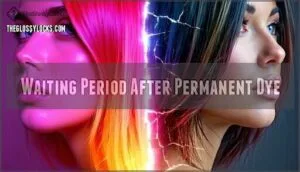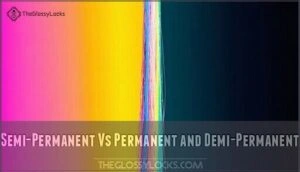This site is supported by our readers. We may earn a commission, at no cost to you, if you purchase through links.

If you want hair that looks healthy while playing with new tones, understanding how these dyes interact is essential. There’s more than meets the eye in every bottle, and your hair’s story shapes how the next chapter unfolds.
Table Of Contents
- Key Takeaways
- Can You Apply Semi-Permanent Dye Over Permanent?
- Preparing Hair for Semi-Permanent Dye
- Bleaching Permanently Dyed Hair Safely
- Using Semi-Permanent Dye After Henna
- Maintaining and Refreshing Color Results
- Semi-Permanent Vs Permanent and Demi-Permanent
- Frequently Asked Questions (FAQs)
- Conclusion
Key Takeaways
- Semi-permanent dye can be applied over permanent color, but results vary depending on your hair’s condition and underlying tones.
- For best results and hair health, wait at least two weeks after permanent dyeing before using a semi-permanent color.
- Bleaching permanently dyed or henna-treated hair carries risks like unpredictable tones and damage, so it should be approached with caution or professional guidance.
- Keeping color vibrant and hair healthy depends on gentle care routines, minimizing heat and chemicals, and choosing products designed for color-treated hair.
Can You Apply Semi-Permanent Dye Over Permanent?
If you’re wondering whether you can put semi-permanent dye over permanent color, you’re not alone. There are a few things you’ll want to know before grabbing your next bottle.
Here’s what you should keep in mind as you get ready to try it.
How Semi-Permanent Dye Works
If you’ve ever wished for a way to change your hair color without a big commitment, semi-permanent dye might be exactly what you’re looking for. This gentle formula sits on the outer hair shaft, offering Color Deposition without altering your natural hair pigmentation.
Semipermanent hair color boosts shine enhancement, gives a quick color boost, and lasts through several washes—usually about 8 shampoos.
Interaction With Permanent Color
Before you reach for a new bottle of color, it helps to know how your previous permanent dye job will affect the look and staying power of any semi-permanent shade you add next. Pigment compatibility really matters—your base can cause color bleeding, unpredictable fading, or change the undertone.
Semi-permanent hair dye often clings differently, so dye longevity depends largely on underlying tones and color correction methods.
Expected Results and Limitations
Here’s what you’ll see with semi-permanent dye over permanent color:
- Color vibrancy is softer and fades with each wash—think gentle pastel, not bold paint.
- Gray blending is subtle, not full coverage, so grays peek through.
- Expect little to no tone change; the fading process is gradual, and hair health usually stays intact compared to permanent dye. Semi-permanent dye is a gentler process because it only coats the hair.
Preparing Hair for Semi-Permanent Dye
Getting your hair ready for semi-permanent color starts with a little groundwork. It’s important to think about what your hair has already been through and what shape it’s in now.
Here’s what you’ll want to keep in mind next.
Assessing Hair Health and Previous Treatments

Strong, healthy hair sets the foundation for vibrant color, but it pays to pause and look closer. Consider your scalp condition, recent dye history, and any signs of mechanical breakage—like split ends or shedding.
Hair health can change after chemical treatments, so assess protein content and watch for hair shaft damage. Chemical treatments can also lead to increased hair porosity, which can affect color absorption.
Sometimes, a waiting period is your safest friend.
Importance of Hair Porosity and Texture
Your hair’s porosity and texture work like a fingerprint—they determine how color grabs hold and how long it stays put. Understanding these factors helps you predict dye absorption and choose the right approach.
Here’s what to watch for:
- Low porosity resists color, making semi-permanent hair dye harder to deposit
- High porosity absorbs quickly but fades fast, especially after bleach sensitivity increases
- Fine texture processes faster than coarse strands during treatment needs
- Coarse texture requires more product and processing time for even color
- Hair porosity directly affects how permanent hair dye altered your base
Your hair color and hair porosity tell the full story before you apply anything new.
Waiting Period After Permanent Dye
If you want your semi-permanent dye to settle in right, giving your hair enough time to recover after permanent color isn’t optional—it’s a must. Wait at least two weeks before applying semipermanent hair dye over permanent hair dye. This waiting period reduces dye reaction risks and allows your hair damage level to stabilize.
Hair care during this time helps lower the color fading rate and protects against further hair damage while root regrowth impact becomes visible, guiding your subsequent dye timing.
Bleaching Permanently Dyed Hair Safely
Bleaching can lift those stubborn permanent color pigments, but it’s not a walk in the park. The process comes with real risks that you’ll want to understand before you start mixing chemicals.
Here’s what you need to know about doing it safely and addressing whatever color surprises pop up.
When Bleaching is Necessary
Sometimes the color you’re working with just won’t budge without a little extra help, and that’s when bleaching steps into the picture. You’ll need to lighten your base color level before semi-permanent dye can deposit properly, especially if permanent color has created a dark foundation that blocks lighter shades from showing through.
When bleaching becomes your path forward:
- Your desired shade is lighter than your current base color level
- Lifting permanent color requires a bleach kit choice matched to your hair texture impact
- Dark pigments won’t fade enough naturally for your new look
- Red undertones appear after bleaching, signaling you’re on the right track
- Your hair’s strength can withstand the process without severe hair dye damage
Risks and Considerations
Ever felt like coloring over coloring is a high-wire act? Bleaching after permanent dye invites chemical interactions and amplifies hair sensitivity, changing fading patterns and making results unpredictable. Forget about complete coverage—semi-permanent dye may only cling where hair is porous, not everywhere. Preparing and repairing hair is essential. Below, see how the odds stack up:
| Risk | Why It Matters |
|---|---|
| Chemical Interactions | Unwanted reactions, uneven tone |
| Hair Sensitivity | Greater breakage, dryness |
| Fading Patterns | Color may patch or bleed |
| Preparation Steps | Reduces risk, improves repair |
| Coverage Limitations | Grays and undertones remain |
Managing Red or Orange Undertones
Warm copper and fiery orange streaks can pop up out of nowhere when you bleach over old color—so what can you do about it? Lean on the color wheel and tone correction to choose neutralizing shades.
Avoiding brassiness often means applying semipermanent hair color in cool or violet hues, or even using a root shadow technique for better blending and hair color correction.
Using Semi-Permanent Dye After Henna
Putting semi-permanent dye over henna isn’t as simple as it sounds. There are a few important things you’ll want to think about before you start. Here’s what you should know going in.
Why Henna-Treated Hair is Challenging
Think of henna as a stubborn shield on your hair—it forms a Henna barrier that locks out most chemical dyes, making color removal tricky. You’re not just battling stubborn pigment, either:
- Chemical reactions may cause odd colors or even damage.
- Protein buildup leaves hair feeling stiff.
- Allergic risks climb, especially with non-pure henna.
Fixing a bad dye job isn’t straightforward.
Recommended Waiting Times
Once you’ve faced the challenges of henna, giving your hair a real break before any new dye adventure can make all the difference. Aim for at least six months of Henna Washout before applying semipermanent hair color or permanent hair dyes.
This pause aids hair health, allows for damage recovery, and gives your strands time to reset dye frequency and re-dye timing.
Color Options for Henna-Processed Hair
Now that your hair has had time to rest, let’s take a look at what shades you can safely try on henna-processed strands.
- Warm semipermanent hair colors (think ruby, copper, or magenta) help mask henna undertones and boost color vibrancy.
- Cooler shades struggle with tone correction and may not take as intended.
- For best dye longevity, choose a hair color option close to your natural henna blend.
Maintaining and Refreshing Color Results
Keeping your color fresh isn’t just about picking the right dye—it’s how you care for your hair afterward. From everyday habits to smart product choices, a little attention goes a long way.
Here’s what you’ll want to keep in mind as you protect and refresh your results.
Hair Care After Dye Application
Even after the color is rinsed away, how you treat your strands in the days that follow makes all the difference in keeping your hair looking vibrant and healthy. Reach for gentle products and skip heat styling when possible.
Prioritize regular trims and quick hair treatments for damage prevention. Consistent care aids both hair repair and your hair’s long-term health and recovery.
Reducing Color Fading
If you want your color to stick around longer, a few simple habits will help keep your shade from washing away too soon.
- Choose gentle shampoos and skip sulfates.
- Rinse with cool water, not hot.
- Deep condition once a week.
- Block sunlight with UV protection.
- Use hair care products made for semipermanent dye.
Those habits slow color fading.
Preventing Damage and Breakage
While you’re enjoying your new color, it’s just as important to watch for signs of stress or weakness in your hair so you can head off damage before it gets out of hand.
Reach for gentle products, limit hot tools, and book regular trims. Hydration masks and protein treatments help maintain hair structure, supporting overall hair health and recovery.
Semi-Permanent Vs Permanent and Demi-Permanent
Before you pick a hair color option, it helps to know how each type works and what results you can expect. Each formula has its own strengths and limitations.
Here’s what you need to keep in mind as you choose the best fit for your hair.
Key Differences in Formula and Results
Ever wonder why some color fades quietly, while others just won’t budge? It all comes down to the Chemical Composition and Mechanism Action in your dye. Here’s how they stack up:
| Semi/Demi Permanent | Permanent |
|---|---|
| ———————-: | : |
| ————–: | |
| Gentle, surface color | Deep, lasting change |
| No ammonia used | Requires ammonia |
| Short-term, less damage | Long-term, more structural change |
| Great for experiments | Ideal for major makeovers |
Coverage of Gray Hair
Depending on the color you choose and the type of dye you use, covering gray hair can feel like chasing down a moving target. Demipermanent hair color is popular for natural shades and subtle Gray Blending, though full gray coverage often requires permanent options. Here’s a quick comparison for spotting the fit:
| Dye Type | Gray Coverage |
|---|---|
| Semi-Permanent | Minimal, blends |
| Demi-Permanent | Soft, blending |
| Permanent | Full coverage |
| Temporary | Short-term fix |
Choosing The Best Option for Your Needs
Trying to pick the right hair color feels a bit like finding the perfect pair of shoes—one size never fits all, and comfort matters just as much as style. Consider your hair goals, lifestyle factors, budget concerns, or how much maintenance you want.
Here’s a simple chart to frame your options:
| Option | Good for… |
|---|---|
| Semi vs Permanent Dye | Quick changes, low damage |
| Advantages of Demipermanent | Soft glow, less upkeep |
| Permanent Hair Color | Big shifts, lasting impact |
Frequently Asked Questions (FAQs)
Is it safe to bleach over henna-treated hair?
Bleaching over henna-treated hair isn’t usually safe. Henna Bleach Risks include unpredictable henna undertones or breakage.
Instead of bleach, look at gentle Henna Removal or Bleach Alternatives to reduce hair damage and protect your hair color investment.
Does bleaching over henna-treated hair have any risks?
Henna bleaching risks include unexpected orange undertones, damage from chemical processing, and stubborn henna removal. You may face patchy results and breakage, making professional guidance key for color correction after bleach or other hair dye consequences.
Can semi-permanent dye stain clothing or bedding?
Semi-permanent dye can easily stain clothing or bedding, especially on light fabrics. Dark vs. light stains behave differently—prevention is key.
Use stain removal tips, cover pillows, wash promptly, and consider fabric types. Professional cleaning helps stubborn spots.
Will semi-permanent color show on dark hair?
Calling a spade a spade, most semi-permanent dye won’t show vibrantly on dark hair unless you lighten it first.
Dark Hair Undertones often mute the color deposit factors, so results appear subtle on the dye visibility scale.
How soon after dyeing can I swim?
For the best hair color maintenance and to limit color fading, wait at least 72 hours before swimming.
Pool chemicals and saltwater effects can dry out newly dyed hair—prioritize hair protection by using gentle post-swim care and hair care products.
Are there allergic reactions to semi-permanent dye?
Reactions like itching, redness, or swelling—classic dye allergy symptoms—can happen even with gentle hair dye. Patch testing importance can’t be overstated.
Seek PPD alternatives, watch for common allergens, and explore hair dye alternatives to reduce reaction risk.
Conclusion
If dyeing hair were a high-wire act, applying semi-permanent dye over permanent would be walking that wire blindfolded—thrilling, uncertain, but possible with the right guide. Your choices and prep decide whether you strike gold or chase clouds of faded color.
Hair holds onto stories, and with care, your next shade can become your favorite chapter. Experiment boldly, nurture each strand, and let each color change reveal another side of you—always a little unexpected, always uniquely yours.









